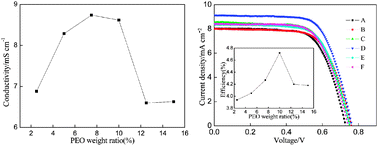The electrically conductive function of high-molecular weight poly(ethylene oxide) (PEO) (Mw = 2 × 106 g mol−1) was investigated when it was used to gelate liquid electrolyte to fabricate a series of polymer gel electrolytes for dye-sensitized solar cells (DSCs). With the PEO weight ratio increasing from 2.5 to 15.0% (vs. liquid electrolyte), rheological behavior measurement showed that the viscosity of the polymer gel electrolytes increased ca 465 times. However, it was observed by steady-state voltammetry and electrochemical impedance spectra (EIS) measurements that the diffusion coefficient of I3−/I− decreased constantly while the conductivity of the polymer gel electrolytes increased initially and then decreased. These two inconsistent behaviours showed that the mobility of Li+ was enhanced by PEO. EIS measurement revealed that the internal resistance of the DSCs were reduced since the enhanced mobility of Li+ was helpful for the transport of electrons within the TiO2 film through an ambipolar diffusion mechanism. When these polymer gel electrolytes were used to assemble DSCs, the conversion efficiency of DSCs increased continuously until it reached its maximum as the PEO weight ratio increased from 2.5 to 10.0%. By optimizing the dye adsorbing time and the thickness of the TiO2 film, a quasi-solid DSC based on a polymer gel electrolyte with a PEO weight ratio of 10.0% showed a considerable conversion efficiency, 6.12 and 10.11% under 100 and 30 mW cm−2 illumination, respectively. Finally, a stability test indicated that the more PEO was added into the polymer gel electrolytes, the better stability was obtained for the corresponding DSCs.

You have access to this article
 Please wait while we load your content...
Something went wrong. Try again?
Please wait while we load your content...
Something went wrong. Try again?


 Please wait while we load your content...
Please wait while we load your content...